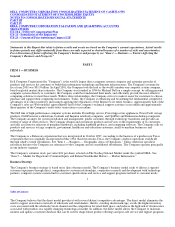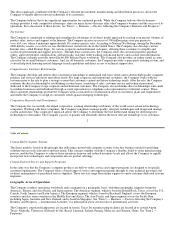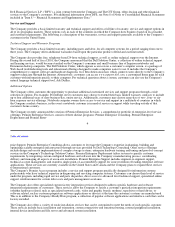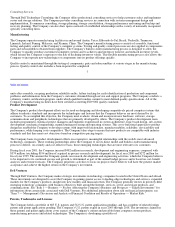Dell 2000 Annual Report Download - page 11
Download and view the complete annual report
Please find page 11 of the 2000 Dell annual report below. You can navigate through the pages in the report by either clicking on the pages listed below, or by using the keyword search tool below to find specific information within the annual report.
parts (which can adversely affect the reliability and reputation of the Company's products), a shortage of components and reduced
control over delivery schedules (which can adversely affect the Company's manufacturing efficiencies) and increases in component
costs (which can adversely affect the Company's profitability).
The Company has several single-sourced supplier relationships, either because alternative sources are not available or the relationship
is advantageous due to performance, quality, support, delivery, capacity or price considerations. If these sources are unable to provide
timely and reliable supply, the Company could experience manufacturing interruptions, delays or inefficiencies, adversely affecting its
results of operations. Even where alternative sources of supply are available, qualification of the alternative suppliers and
establishment of reliable supplies could result in delays and a possible loss of sales, which could affect operating results adversely.
Risk on financial instruments
The Company regularly utilizes derivative instruments to hedge its exposure to fluctuations in foreign currency exchange rates and
interest rates. In addition, the Company utilizes equity instrument contracts to execute repurchases of its common stock under its
Board-authorized stock repurchase program. Some of these instruments and contracts may involve elements of market and credit risk
in excess of the amounts recognized in the Consolidated Financial Statements. For
11
Table of Contents
additional information about risk on financial instruments, see "Item 7 — Management's Discussion and Analysis of Financial
Condition and Results of Operations — Market Risk."
Strength of infrastructure
The Company's continued success and profitability partly depends on its ability to continue to improve its infrastructure (particularly
personnel and information systems) in order to increase operational efficiencies.
Patent rights
The Company's continued business success may be largely dependent on its ability to obtain licenses to intellectual property
developed by others on commercially reasonable and competitive terms. If the Company or its suppliers are unable to obtain desirable
technology licenses, the Company could be prohibited from marketing products, could be forced to market products without desirable
features or could incur substantial costs to redesign its products, defend legal actions or pay damages.
Equity investments
The Company has an active venture capital program, through which the Company makes strategic equity investments primarily in
privately held technology companies. See "Item 1 — Business — Dell Ventures." Because these companies are typically early-stage
ventures with either unproven business models, products that are not yet fully developed or products that have not yet achieved market
acceptance, these investments are inherently risky. Many factors outside of the Company's control determine whether or not the
Company's investments will be successful. Such factors include the ability of a company to obtain additional private equity financing,
to access the public capital markets, to effect a sale or merger, or to achieve commercial success with its products or services.
Accordingly, there can be no assurances that any of the Company's investments will be successful or that the Company will be able to
recover the amount invested.
Trademarks and Service Marks
Unless otherwise noted trademarks appearing in this Report are trademarks of the Company. The Company disclaims proprietary
interest in the marks and names of others.
Executive Officers of the Company
The following table sets forth the name, age and position of each of the persons who were serving as executive officers of the
Company as of May 1, 2001.
Name Age Title
Michael S. Dell 36 Chairman of the Board and Chief Executive Officer
Kevin B. Rollins 48 President and Chief Operating Officer
James T. Vanderslice 60 President and Chief Operating Officer
Paul D. Bell 40 Senior Vice President, Europe, Middle East and Africa and Home and Small Business Group
Thomas B. Green 46 Senior Vice President, Law and Administration and Secretary
Michael D. Lambert 54 Senior Vice President, Enterprise Systems Group
Joseph A. Marengi 47 Senior Vice President, Relationship Group
Rosendo G. Parra 41 Senior Vice President, Home and Small Business Group
James M. Schneider 48 Senior Vice President and Chief Financial Officer
12
























